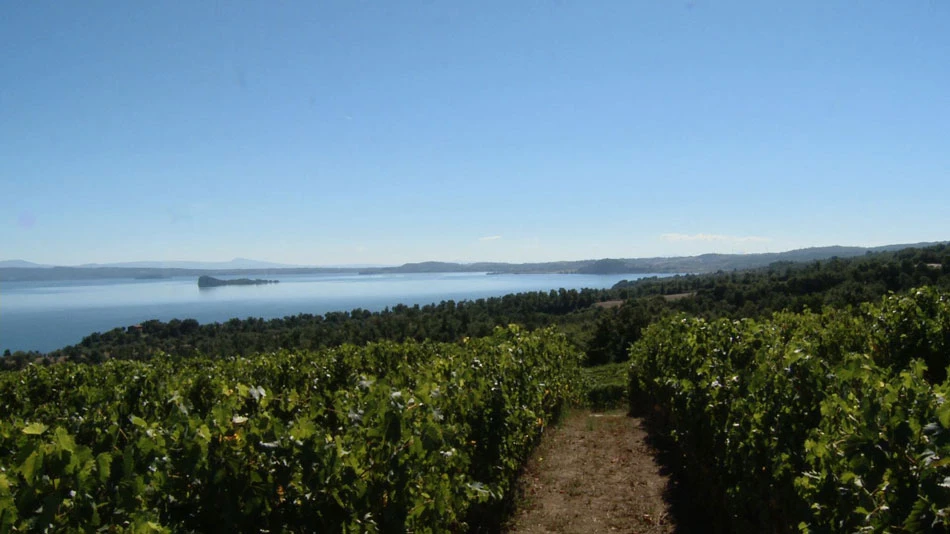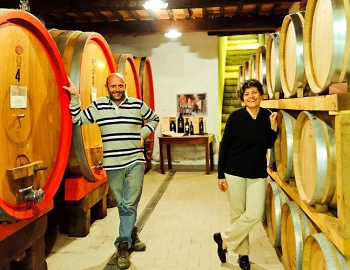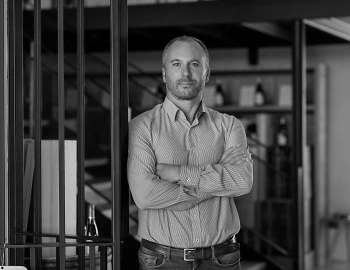Villa Caviciana
When, in the early morning, the sun slowly rises over the glittering mirror-smooth water of the Bolsena Lake, and the first blaring of the sheep, the quiet meowing of the domestic cat and the cheerful chirping of birds break the peaceful silence, then one understands that some people have found here their paradise on earth. Away from the big mass tourism of the coast, only an hour's drive away, in still largely intact nature, the lake spreads out in the charming hilly landscape, sometimes calm, sometimes foaming up, wild like the sea.
Before the Romans, Lazio was the land of the Etruscans. Time and again one comes across contemporary witnesses of that culture. The name Caviciana is derived from the ancient Etruscan name of the area where the vines grow today. The sphinx that adorns the name is a delicate Etruscan sculpture found in the surrounding caves. It stands for immortality.
Red wines from Villa Caviciana
from Villa Caviciana
The almost circular Lake Bolsena is a collapsed volcanic crater (150 metres deep!) located in the Lazio region (approx. 90 kilometres north of Rome), which adjoins Tuscany and Umbria. Mocca and Fritz Metzeler came here in the 1990s during a trip through Italy. The grandiose landscape fascinated them and became their retreat, their little paradise for the holidays. Gradually they acquired land, olive trees, vines and animals. Today, the estate covers 140 hectares on the northern shore of the lake, 20 of which are planted with vines. 6000 olive trees, several hundred mangalitsa wool pigs and a herd of ragged sheep. The entire estate has been certified organic since 2006 and, with around 20 employees, is one of the largest employers in the Viterbo region.
The Swiss Daniel Eigenheer is responsible for the vineyard and wine sectors. The first vines were planted in 2002: the autochthonous Sangiovese and Aleatico, the international varieties Chardonnay, Sauvignon Blanc, Merlot, Cabernet Sauvignon and Cabernet Franc as well as the Tannat, which seems exotic in this area and comes from the south of France. The Mediterranean climate with hot summers and not too cold winters benefits these grape varieties, which ripen mainly late. The vineyards are situated at an altitude of 350 to 550 metres above sea level with a view of the lake. In summer, there is always a pleasant wind blowing from the Mediterranean, which dries the grapes quickly after the rain and soothes the heat. In the winter months, the Tramontana blows cold from the north. Hail can sometimes cause great damage. These favourable climatic conditions facilitate the careful and environmentally conscious care according to biological guidelines. The tuff, sand and loess loam soils are of volcanic origin.
The harvest at Villa Caviciana starts in August with the Aleatico for the fresh Rosé Tadzio and ends in October with the Aleatico for the sweet wine Maddalena. However, it is not allowed to rain, because otherwise the fruits drying on the plant would rot very quickly. The hand-picked grapes are brought to the winery in small crates. The modern, simple yet striking building was built from local tuff - the traditional building material - and blends harmoniously into the landscape. The design of the building is based on careful vinification according to the principle of gravity, so that coarse pumping can be avoided. Only own grapes are processed. All wines are vegan. They have already won several medals at the International Organic Wine Award.
The names of the wines have their roots in German poets, writers and painters who travelled and loved Italy. They represent the cultural bridge between Italy and Germany. Filippo Miller was Goethe's pseudonym during his trip to Italy; Faustina was his Italian mistress, but her christening was Maddalena. Letizia is a mistress from Heinrich Heine's work "Die Bäder von Lucca" and Eleonora reminds us of the actress Eleonora Duse, with whom Rainer Maria Rilke fell in love. Anna Risi also knew how to seduce the painter Feuerbach with her beauty. Tadzio, finally, is the beautiful young man from Thomas Mann's novella "Death in Venice".

Producer

The Wild Alps
In 2016, Theresia Angel-Hämmerle and Peter Angel from Vorarlberg founded “The Wild Alps”, based in Balgach, Switzerland, to develop and produce an exceptional portfolio of fine spirits. Their vision was to capture the quintessence of gin, whisky, rum and vodka to really excite aficionados.

Podere Le Bèrne / Fam. Natalini
Winemaker Andrea Natalini and his nephew Frederico, the budding oenologist at the winery, are the pillars of the family business. But at Le Bèrne, everyone pitches in to make great wines! Wines of excellent quality at fair prices, authentic, warm-hearted, and inviting, just like their producers. Welcome to Italy!

Domaine Julien Brocard
The seven vineyards - Chablis "naturally"
Julien Brocard's domaine is located in Préhy, just a few kilometres from the town of Chablis in northern Burgundy. The aim of the domaine is to bring out the true character of the wines without any distortion, and for this purpose the vines have been cultivated biodynamically since 2011.




